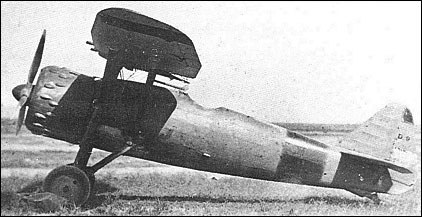|
| Transferred by the SAF-Avions Dewoitine to the Liore-et-
Olivier (LeO) concern owing to the workload imposed
on the parent company by the D 50bis (future D
500), the D 37 (later D 370) was a private venture contender
in the 1930 C1 programme. The prototype, flown
on 1 October 1931, was powered by a 700hp Gnome-
Rhone 14Kbrs Mistral Major 14-cylinder two-row radial.
It was subsequently subjected to an extensive series of
modifications: a G-R 14Kbs engine gave place, in turn,
to a G-R 14Kds affording 800hp for take-off and 740hp
at 4500m; the engine cowling was
changed; the undercarriage was redesigned, and the
wing introduced dihedral and reduced chord. Yet more redesign was embodied by a second prototype, the
D 371, which appeared late February 1934. Twenty-eight
D 371s were ordered for the Armee de l'Air with
the G-R 14Kf s engine of 930hp for take-off and 880hp at
3250m, and an armament of four underwing
7.5mm MAC 34 machine guns. Fourteen were ordered
by Lithuania, and these, having two synchronised
7.7mm Browning guns in the fuselage and two Darne
guns of similar calibre in the wings, were designated D
372s. Twenty were ordered for the Aeronautique
Navale as D 373s, these having flotation gear, an 30cm reduction in wing span and an armament of
four Darne guns within the wing. A further 25 ordered
for this service with aft-folding wings were designated
as D 376s. The last D 371 left the factory at the end of
December 1935, the Armee de l'Air fighters following
the Navy's D 373s. The Lithuanian government meanwhile
relinquished its D 372s in favour of D 501s, the
former being sold to the Spanish Republican government
and ferried to Spain during August 1936, where
they were later joined by 10 of the 28 Armee de l'Air
D 371s. The remaining D 371s equipped an escadrille at
Bizerte, Tunis, until 1939, but were little flown owing to
constant problems with their engines. The D 373s and
D 376s of the Aeronautique Navale suffered similarly, and by September 1939, only 13 D 373s and nine D 376s
were on strength, all being withdrawn before the
year's end.
| MODEL | D 371 |
| WEIGHTS |
| Take-off weight | 1884 kg | 4154 lb |
| Empty weight | 1320 kg | 2910 lb |
| DIMENSIONS |
| Wingspan | 11.22 m | 37 ft 10 in |
| Length | 7.44 m | 24 ft 5 in |
| Height | 3.40 m | 11 ft 2 in |
| Wing area | 17.45 m2 | 187.83 sq ft |
| PERFORMANCE |
| Max. speed | 380 km/h | 236 mph |
| Range | 900 km | 559 miles |
 | A three-view drawing of D 371 (800 x 562) |
| GrahamClayton, e-mail, 29.12.2024 10:32 The last of the monoplane parasol fighter developed by Dewoitine. reply |
|
Do you have any comments?
|
| 
COMPANY
PROFILE
All the World's Rotorcraft
|









